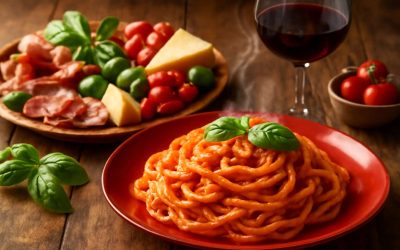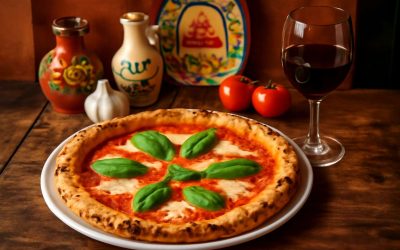Overview of Italian and American Cuisine
Historical Background of Italian Food
Italian food vs American is a debate that stirs passionate opinions across continents, but understanding their roots reveals fascinating contrasts. Italian cuisine, with its centuries-old history, is a tapestry woven from regional traditions, local ingredients, and a deep reverence for simplicity and seasonality. Its origins trace back to ancient Roman and Etruscan civilizations, evolving through centuries of cultural exchange and culinary innovation.
In contrast, American cuisine is a melting pot born from immigration and innovation, constantly reinventing itself. It blends diverse culinary influences—from Native American staples to European, African, and Asian flavors—creating a dynamic and ever-changing food landscape. This rich history makes the comparison of Italian food vs American not just about taste, but about the cultural stories each cuisine tells. The evolution of Italian food, in particular, highlights a commitment to tradition while adapting to modern palates, making it a timeless staple in global gastronomy.
Evolution of American Cuisine
Italian cuisine, with its roots stretching back thousands of years, embodies a harmonious balance of tradition and artistry. Its evolution is a testament to regional diversity, where each village and city has contributed unique flavors, techniques, and stories to the culinary tapestry. From the rich, hearty pastas of the north to the sun-kissed tomatoes of the south, Italian food has maintained a reverence for seasonality and simplicity that resonates worldwide. This deep cultural heritage often contrasts sharply with the dynamic evolution seen in American cuisine.
The story of American cuisine is one of relentless reinvention. Born from a melting pot of cultures—Native American, European, African, and Asian—its culinary landscape is a vivid mosaic of innovation. Over the centuries, American food has absorbed influences from global migrations, creating a flexible and ever-adapting gastronomic identity. This continuous transformation has led to the emergence of iconic dishes and trends that reflect the country’s spirit of experimentation. For example, the rise of comfort foods like burgers and fried chicken showcases how American cuisine celebrates both tradition and innovation in the culinary arts.
- Native American staples laid the foundation for early American food, emphasizing ingredients like maize, beans, and squash.
- European settlers introduced baking, dairy, and wine-making traditions, enriching the local palate.
- The 20th century saw an explosion of fast-food culture, alongside farm-to-table movements that champion fresh, local ingredients.
In the ongoing debate of italian food vs american, it’s fascinating to see how each cuisine tells a different story—one rooted in centuries-old tradition, the other in a spirit of constant reinvention. Both offer a rich culinary experience, yet their evolution highlights distinct cultural philosophies that continue to influence global tastes today.
Key Ingredients and Flavors
Traditional Italian Ingredients
When exploring the vibrant tapestry of italian food vs american, the key ingredients reveal much about their cultural essence. Italian cuisine is celebrated for its simplicity and freshness, relying heavily on olive oil, garlic, basil, and ripe tomatoes—each ingredient bursting with natural flavor. These ingredients create a symphony of tastes that evoke the sun-soaked landscapes of Italy.
In contrast, American cuisine often embraces bold, hearty components like beef, corn, and potatoes, reflecting the diverse immigrant influences and frontier spirit. While Italian dishes might highlight delicate herbs and cheese, American recipes often feature smoky BBQ sauces and rich gravies that satisfy craving for comfort and abundance.
Traditional Italian ingredients for flavor include:
- Extra virgin olive oil
- Fresh basil and oregano
- Parmigiano-Reggiano cheese
- Sun-dried tomatoes
The differences in key ingredients underscore the essence of each culinary style—one rooted in regional simplicity, the other in bold, multicultural experimentation. These nuances are what make comparing italian food vs american so endlessly fascinating and delicious!
Signature American Ingredients
When comparing Italian food vs American, the core ingredients reveal the culinary philosophies behind each culture. Italian cuisine is renowned for its emphasis on fresh, high-quality ingredients that let natural flavors shine. Think extra virgin olive oil, fragrant basil, aged Parmigiano-Reggiano, and sun-dried tomatoes—simple, yet profoundly satisfying. These components create a tapestry of taste that transports you straight to Italy’s sun-drenched landscapes.
Meanwhile, American cuisine leans into boldness and heartiness, with signature ingredients like beef, corn, and potatoes taking center stage. These staples reflect the melting pot of influences—from European immigrants to frontier ingenuity. American dishes often feature smoky BBQ sauces, rich gravies, and spice blends that satisfy a craving for comfort and abundance. To illustrate, here are some signature American ingredients:
- Barbecue sauce
- Cheddar cheese
- Potatoes
- Corn
Ultimately, the contrast between Italian food vs American isn’t just about ingredients; it’s a reflection of cultural identity—one rooted in regional simplicity, the other in multicultural experimentation. Both styles offer a feast for the senses, proving that food really is a universal language with endless dialects to discover.
Cooking Styles and Techniques
Authentic Italian Cooking Methods
When it comes to cooking styles, Italian food vs American often feels like comparing a refined ballet to a high-energy jam session. Authentic Italian cooking methods emphasize simplicity, letting high-quality ingredients shine. Think gently simmered sauces and hand-rolled pasta—no shortcuts, just artistry in every fold and fold-back of dough. The secret? Respect for tradition and a sense of patience that would make even the most seasoned chef nod in approval.
In contrast, American cuisine is renowned for its bold experimentation and an unapologetic love affair with fusion. Techniques are often fast-paced, with grilling, deep-frying, and baking serving as the backbone of many iconic dishes. Sometimes, the difference boils down to this: Italians cherish slow, deliberate processes, while Americans prefer quick, satisfying results. To capture the essence of Italian food vs American, understanding these distinct approaches is key.
For those who want to delve deeper, here’s a quick glance at traditional Italian cooking methods:
- Slow simmering for rich sauces
- Handcrafting pasta from scratch
- Wood-fired pizza baking
- Use of fresh herbs and seasonal ingredients
These techniques highlight the meticulous craftsmanship that sets authentic Italian food apart from the often more improvisational American culinary style.
American Fusion and Innovation
In the shadowed corridors of culinary innovation, American cuisine often feels like a tempest—an unrestrained symphony of bold flavors and daring fusions. It’s a landscape where grilling, deep-frying, and baking are not just techniques but acts of rebellion against tradition. The American love for experimentation breathes life into iconic dishes, transforming humble ingredients into expressive culinary sculptures. This spirit of innovation is the heartbeat of the American approach, where rapid results often triumph over meticulous craftsmanship.
Yet, the contrast with Italian food vs American is stark and poetic. Italian cuisine whispers rather than shouts—its techniques rooted in patience, reverence for ingredients, and an almost sacred respect for tradition. The slow simmering of sauces and hand-rolled pasta evoke a sense of artistry that transcends mere sustenance. For those seeking a taste of this ancient craft, it’s the subtle mastery of these methods that elevates Italian food from nourishment to an evocative experience.
In fact, the difference often boils down to this: while Americans embrace the thrill of rapid innovation, Italians cherish the slow, deliberate process—each step a testament to centuries of culinary artistry. The allure of Italian food vs American lies in this eternal dance of tradition versus invention, each with its own dark charm and undeniable appeal.
Popular Dishes and Food Staples
Iconic Italian Dishes
Italian food vs American cuisine each tell a story of cultural identity and culinary evolution. When it comes to popular dishes, Italy is renowned for its pasta—think creamy risottos, fresh gnocchi, and hearty lasagna. These dishes emphasize simplicity, quality ingredients, and time-honored methods. Meanwhile, American cuisine boasts a diverse array of comfort foods—think juicy burgers, crispy fried chicken, and smoky barbecue. These dishes often reflect regional influences and a penchant for bold flavors.
Food staples form the backbone of each cuisine. In Italy, staples like olive oil, fresh tomatoes, and basil create a foundation for countless dishes, emphasizing freshness and artisanal preparation. Conversely, American staples include corn, potatoes, and wheat, which support a wide variety of fast-food staples and hearty meals. The contrast between these staples highlights the differences in ingredient availability and culinary philosophy.
For those interested in iconic Italian dishes, classics like pizza Margherita, Osso Buco, and Tiramisu stand out. These dishes are celebrated worldwide for their simplicity and flavor depth. American favorites, on the other hand, include dishes like clam chowder, fried chicken, and apple pie, each representing regional tastes and culinary ingenuity. Comparing Italian food vs American reveals how each cuisine balances tradition and innovation, creating unique dining experiences.
Classic American Dishes
When exploring the realm of italian food vs american cuisine, the diversity of popular dishes reveals much about each culture’s culinary soul. Italian cuisine is celebrated for its pasta—delicate, handcrafted, and bursting with flavor. Think creamy risottos, fluffy gnocchi, and rich lasagna layers, each emphasizing simplicity and freshness. On the other side, American cuisine boasts an array of comfort foods that have become global icons. Juicy burgers, crispy fried chicken, and smoky barbecue are staples that showcase regional flair and a love for bold, hearty flavors.
Food staples further distinguish these two culinary worlds. Italian staples like olive oil, ripe tomatoes, and fragrant basil serve as the backbone for countless dishes, emphasizing artisanal quality and seasonal ingredients. Meanwhile, American staples such as corn, potatoes, and wheat underpin a variety of fast-food favorites and hearty meals. This contrast in ingredients underscores not just geographical differences but also distinct culinary philosophies—simplicity versus innovation.
Cultural Influences and Regional Variations
Regional Italian Cuisines
Italian food vs American cuisine embodies more than just flavors; it reflects the rich tapestry of cultural influences and regional variations that define each culinary tradition. Italy’s diverse regional cuisines, from the sun-drenched coasts of Sicily to the alpine heartlands of Trentino, showcase an astonishing variety of ingredients and cooking styles. These local flavors are deeply rooted in history, shaped by centuries of regional customs and natural bounty, creating a mosaic that is both authentic and deeply rooted in tradition.
In contrast, American cuisine is a reflection of a melting pot, where immigrant influences meld into innovative culinary expressions. The regional variations across the United States—from the smoky barbecue of the South to the seafood delicacies of New England—highlight a dynamic evolution. This fusion of cultures results in a cuisine that is constantly reinventing itself, often blending elements of italian food vs american with a modern twist. Understanding these regional nuances provides a deeper appreciation of how geography and history influence culinary identity, making each cuisine a living narrative of cultural exchange and adaptation.
Regional American Cuisines
Across the vast tapestry of American landscapes, regional cuisines tell stories as diverse and colorful as the nation itself. From the fiery spices of Cajun Louisiana to the tangy citrus flavors of Florida’s Keys, American cuisine is a mosaic of cultural influences that have evolved over centuries. These regional variations—such as the hearty stews of the Midwest or the inventive fusion dishes of California—are a testament to America’s melting pot heritage. Each area’s culinary identity is shaped by geography, history, and immigrant communities, forging a dynamic contrast to the more homogeneous yet equally rich traditions of Italian food vs American.
Within this culinary diversity, regional American cuisines often feature distinct ingredients and cooking techniques, creating a vibrant tapestry that celebrates innovation and tradition. For example, the smoky barbecue of the South, the fresh seafood of New England, or the spicy Tex-Mex fusion in the Southwest—each region offers a unique flavor profile. These regional variations highlight the importance of local ingredients and cultural influences, making American cuisine a living evolution, constantly reinventing itself while honoring its roots. Such diversity makes the comparison of italian food vs american all the more fascinating, revealing a culinary landscape that’s as expansive and varied as the country itself.
Health and Nutrition Aspects
Nutritional Profile of Italian Food
When it comes to health and nutrition, Italian food vs American cuisine showcase stark contrasts rooted in their traditional ingredients and cooking methods. Italian dishes often emphasize fresh, seasonal produce, olive oil, and lean proteins, making them inherently heart-healthy. Conversely, American cuisine tends to lean heavily on processed foods, refined sugars, and red meats, which can contribute to higher rates of obesity and cardiovascular issues. Interestingly, the nutritional profile of Italian food is rich in monounsaturated fats and antioxidants, thanks to ingredients like tomatoes, garlic, and extra-virgin olive oil.
For those concerned about balanced eating, Italian cuisine offers a natural advantage. A typical Italian meal might include a serving of vegetables, a moderate portion of whole grains like pasta or risotto, and a light protein such as seafood or poultry. Meanwhile, American dishes often prioritize larger portions and calorie-dense ingredients. This difference highlights how the Italian approach to eating can promote better long-term health, especially when compared to the often more indulgent American diet. The choice between Italian food vs American can significantly impact nutritional habits and overall wellness.
American Food and Dietary Trends
In the shadowed corridors of culinary tradition, American food and italian food vs american reveal stark contrasts that whisper tales of cultural evolution. American cuisine, with its penchant for processed foods and calorie-laden dishes, often mirrors the frenetic pace of modern life—an insatiable hunger for convenience masked as sustenance. Meanwhile, the heart of Italian food vs american lies in the purity of ingredients and a reverence for balance, even as fast-food chains threaten to drown the authentic taste of Italy in a sea of grease and sugar.
Dietary trends in America lean heavily toward larger portions and comfort foods, often at the expense of nutrition. However, a deeper look uncovers a movement—a quiet rebellion against the excess—favoring organic, whole foods, and mindful eating. The rise of plant-based diets and farm-to-table philosophies echoes the Italian emphasis on seasonal produce and simple, wholesome ingredients. For those seeking a healthier path, understanding the differences in italian food vs american reveals the subtle art of nourishing the body with nature’s bounty rather than processed convenience.
Eating Habits and Dining Culture
Italian Dining Customs
When it comes to eating habits and dining culture, Italian food vs American reveals two distinct worlds—each rooted in tradition and social significance. Italians cherish the art of lingering over meals, turning dining into a shared experience that fosters connection and warmth. In contrast, American dining often emphasizes efficiency, with quick meals and on-the-go options becoming the norm. This difference reflects broader cultural values: Italy’s focus on savoring every bite and American pragmatism in balancing taste with convenience.
Italian dining customs revolve around a structured sequence—antipasto, primo, secondo, and dolce—highlighting respect for culinary craftsmanship. Meanwhile, American meals tend to be more flexible, often blending multiple cuisines into fusion dishes that mirror the country’s diverse melting pot. Interestingly, the social aspect remains central in both cultures, but Italian meals are almost sacred, often lasting hours with lively conversations, whereas American dining emphasizes speed and practicality. Understanding these nuances enriches the appreciation of how Italian food vs American cuisine shapes their respective identities.
American Eating Culture
American eating culture is a whirlwind of efficiency, where meals often double as pit stops rather than leisurely pursuits. In the United States, grabbing a burger or a slice of pizza on the run is practically a national pastime, reflecting a broader societal emphasis on pragmatism and time management. This rush often leads to quick bites at fast-food joints or convenience store snacks, turning dining into a necessity rather than a cherished ritual.
Unlike Italian food vs American, where Italy’s culinary customs emphasize a structured, multi-course experience, American dining champions flexibility and fusion. Many Americans enjoy blending cuisines—think Tex-Mex or Korean BBQ burritos—highlighting the country’s melting pot identity. Here, the focus is on satisfying hunger swiftly, often sacrificing the social, lingering aspect that characterizes Italian meals.
- Fast food dominates American eating habits, with drive-thrus and takeout being staples.
- Meals are often designed for convenience, with quick preparation and consumption.
- Social dining is more about efficiency and practicality than extended conversations over a shared plate.
In essence, American eating culture values speed without entirely sacrificing flavor, making it a fascinating contrast to the Italian approach of savoring each bite and turning dining into an art form. The difference is stark but tells a lot about each nation’s unique cultural DNA—quick, pragmatic American dining versus the slow, ceremonious Italian food vs American experience.
Global Influence and Popularity
Italian Cuisine Worldwide
Across the shadowy corridors of culinary influence, Italian cuisine has cast a spell that stretches far beyond its rustic borders, enchanting the global palate with its timeless allure. Its influence is undeniable, whispering tales of sun-drenched vineyards and ancient trattorias into the hearts of food enthusiasts worldwide. When pondering the saga of italian food vs american, one cannot ignore the sheer cultural resonance that Italian flavors evoke—an exotic elegance rooted in centuries of tradition.
In the grand theater of global gastronomy, Italian cuisine stands as a pillar of authenticity and artistry. Its dishes continue to dominate international menus, from bustling city streets to remote corners of the world, inspiring countless adaptations and fusions. Meanwhile, American cuisine—an eclectic mosaic—has evolved through innovation and regional reinvention, carving its unique identity into the fabric of global food culture. This ongoing duel between italian food vs american is more than a culinary comparison; it is a reflection of contrasting philosophies—one rooted in tradition, the other in constant reinvention.
American Cuisine’s Global Reach
The global influence of American cuisine is nothing short of astonishing, carving out a sizable footprint on the world’s dining landscape. Its adaptability and regional reinventions have propelled American food to international prominence, making it a staple in countless countries, including South Africa. From classic burgers and fries to inventive fast-casual concepts, American cuisine continues to shape modern eating habits worldwide. This widespread popularity is driven by a dynamic culinary ethos that embraces innovation and diversity, appealing to an ever-expanding audience.
In the ongoing debate of italian food vs american, the latter’s global reach is undeniably impressive. Its ability to evolve—adapting local ingredients and flavors—has cemented its place in diverse culinary scenes. As American cuisine transcends borders, its influence often blends seamlessly with local traditions, creating unique fusion dishes. The versatility of American food, combined with its emphasis on comfort and familiarity, fuels its appeal across continents, including South Africa. This contrast between classic Italian authenticity and American innovation continues to fascinate food enthusiasts worldwide, fueling a perpetual dialogue about culinary identity and cultural exchange.
Sustainable Practices and Food Sourcing
Sustainability in Italian Food Production
Sustainable practices and food sourcing sustainability are increasingly shaping the narrative of italian food vs american cuisine. Italy’s culinary tradition is rooted in a profound respect for the land, emphasizing local, seasonal ingredients that are often sourced directly from small-scale farmers. This approach not only preserves regional biodiversity but also reduces carbon footprints, aligning with global efforts to promote environmentally conscious eating.
In contrast, American culinary practices have historically been more varied, with a tendency towards industrial-scale sourcing. However, recent shifts are evident—many American restaurants and food producers now prioritize organic, non-GMO, and locally sourced ingredients. This movement reflects a broader societal desire for transparency and sustainability, emphasizing that food production can be both ethical and flavorful.
To deepen this commitment, some establishments adopt practices such as composting, water conservation, and supporting fair-trade suppliers. These efforts highlight that the conversation around sustainability in food extends beyond just ingredients. It’s about cultivating a responsible culinary culture that respects the environment—an idea that resonates deeply when comparing italian food vs american cuisine. Embracing these principles not only enriches the dining experience but also fosters a more sustainable future for generations to come.
American Food Industry and Sustainability
The American food industry has undergone a remarkable transformation in recent years, shifting from sprawling industrial farms to a more conscious approach rooted in sustainability. While fast food and mass production once dominated the landscape, there’s now a growing emphasis on organic, non-GMO, and locally sourced ingredients. This pivot isn’t just a fad; it’s a reflection of societal demand for transparency and ethical practices.
Many American restaurants and food producers are adopting sustainable practices such as composting, water conservation, and supporting fair-trade suppliers. These efforts demonstrate that American food isn’t just about quantity—it’s increasingly about quality and responsibility. To illustrate, some establishments follow a
- locally sourced ingredients
- zero waste policies
- eco-friendly packaging
approach, proving that American cuisine can be both innovative and environmentally conscious.
In the ongoing debate of italian food vs american, the American industry’s evolving sustainability initiatives highlight an impressive shift towards responsible culinary practices—an effort that aligns well with global environmental goals. After all, a dish can be delicious and sustainable at the same time, making the American food scene more appealing than ever to eco-minded consumers.




0 Comments